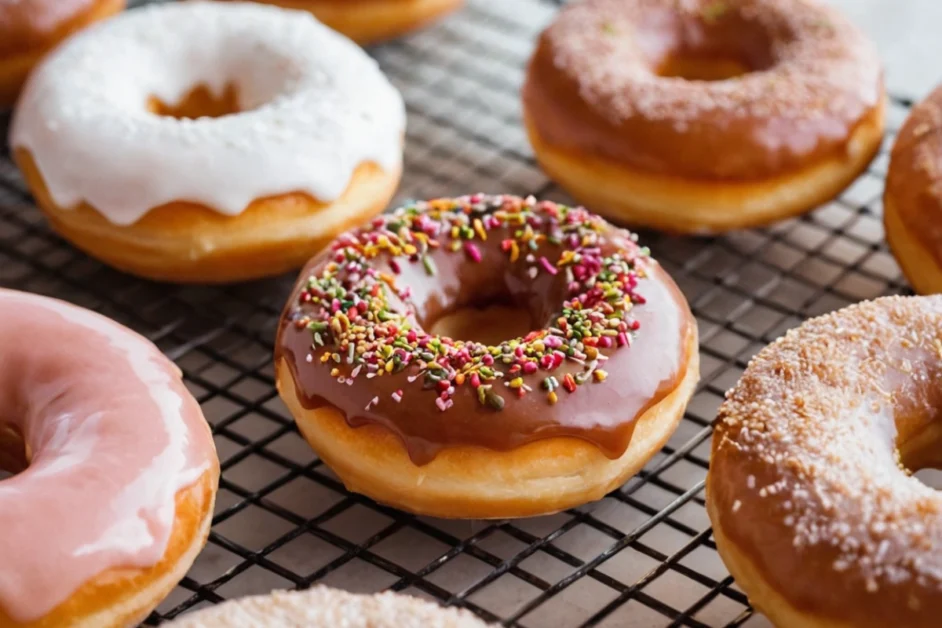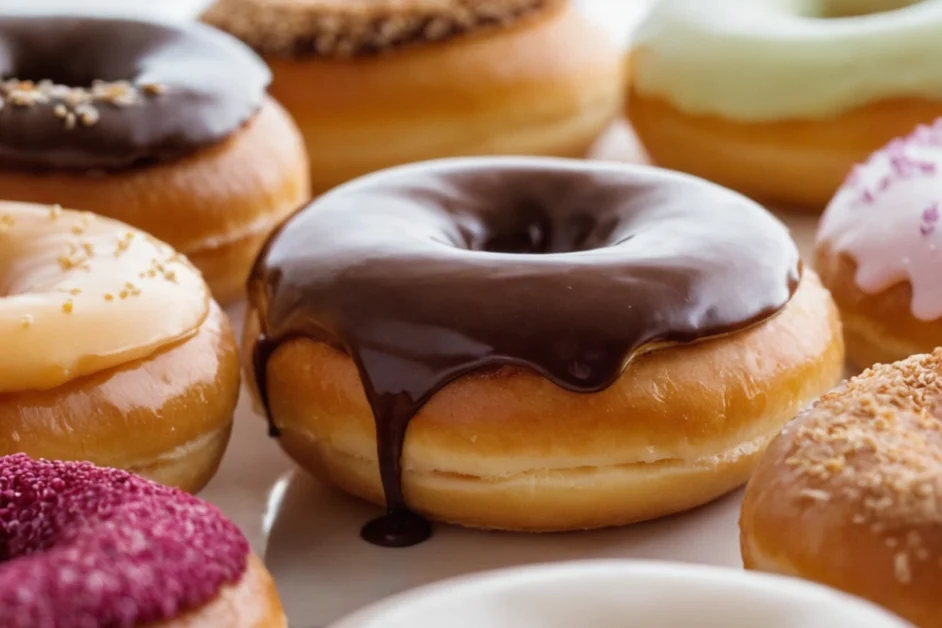Plain donuts have long been a staple in bakeries across the United States. Their simple yet satisfying taste, soft texture, and versatility make them a beloved treat. Whether served plain or dusted with powdered sugar, they bring comfort with every bite.
In this article, we’ll explore the fascinating history of plain donuts, break down their types, and walk through the ingredients and techniques required to make them at home. We’ll also dive into variations, FAQs, and why they remain a timeless favorite. Ready to learn everything about plain donuts? Let’s get started.
Explore more easy recipes like this Easy 3-Ingredient Sloppy Joe Recipe
The History of Plain Donuts
The roots of donuts can be traced back to the early 19th century when settlers in America brought fried dough recipes from Europe. Over time, these recipes were refined into what we now know as donuts. Plain donuts, in particular, emerged as a popular version due to their simplicity.
Early American bakers preferred plain versions because they were quick and easy to make, using just a few essential ingredients like flour, sugar, and milk. Over time, donuts grew in popularity, and though many varieties now include toppings or fillings, the humble plain donut remains a favorite for its nostalgic charm.
Today, plain donuts continue to be a go-to choice for their light flavor and adaptability, holding a special place in coffee shops and bakeries across the country.
Why Plain Donuts Are Timeless
What is it about plain donuts that keeps people coming back for more? The answer lies in their versatility and nostalgic appeal. Plain donuts are neither too sweet nor too rich, making them the perfect companion for coffee or tea. Their simple flavor allows them to be enjoyed as-is, or you can easily dress them up with powdered sugar, cinnamon, or glaze.
Here’s why they stand the test of time:
- Simplicity: Less sweet than other types, plain donuts pair well with different flavors.
- Versatility: You can enjoy them plain or with a variety of toppings.
- Nostalgia: For many, plain donuts bring back memories of childhood mornings and family gatherings.
Types of Plain Donuts
Despite their simplicity, plain donuts come in several types, each with its own unique qualities. Here’s a look at the main variations:
Yeast-Based Plain Donuts
Yeast donuts are made with yeast as the leavening agent, giving them a light and airy texture. These donuts take longer to make since the dough needs time to rise. However, the end result is a soft and fluffy donut that practically melts in your mouth.
Cake-Based Plain Donuts
Cake donuts are denser and rely on baking powder for leavening. These donuts have a firm, tender texture, making them perfect for dunking into coffee. Unlike yeast donuts, cake donuts don’t need time to rise, so they’re quicker to prepare.
Old-Fashioned Plain Donuts
Old-fashioned donuts are a type of cake-based donut. Typically made with sour cream or buttermilk, they have a slightly tangy flavor. They are known for their crispy edges and soft, cake-like interior, which makes them a favorite among donut lovers who enjoy texture contrasts.
Ingredients and Techniques for Making Plain Donuts
Whether you’re making yeast-based or cake-based plain donuts, the ingredients remain relatively simple. Here’s what you’ll need to get started:
Common Ingredients:
- Flour: Provides structure.
- Sugar: Adds a hint of sweetness.
- Eggs: Helps bind the dough.
- Milk: Adds moisture.
- Yeast or Baking Powder: Depending on the type of donut.
- Oil for Frying: Canola or vegetable oil works best due to its neutral flavor and high smoke point.
Key Techniques:
- Dough Preparation: For yeast donuts, it’s crucial to give the dough enough time to rise properly. This ensures a soft, fluffy texture. Cake donuts, on the other hand, require careful mixing to avoid overworking the batter, which could lead to tough donuts.
- Frying Temperature: The oil should be heated to around 350°F (180°C). Too hot, and your donuts will burn on the outside and remain raw inside. Too cold, and they will absorb too much oil, becoming greasy.
- Shaping the Donuts: A donut cutter is helpful, but you can also use a round glass for the main donut and a small bottle cap for the hole.
Step-by-Step Guide to Making Plain Donuts
Here’s how you can make plain donuts at home with this easy-to-follow recipe.
Ingredients:
- 3 cups all-purpose flour
- ½ cup sugar
- 2 teaspoons baking powder (for cake donuts) or 1 packet of active dry yeast (for yeast donuts)
- 1 cup milk
- 2 eggs
- ¼ cup butter, melted
- Neutral oil for frying (e.g., canola oil)
Instructions:
- Prepare the Dough
In a large bowl, combine the flour, sugar, and your leavening agent (yeast or baking powder). In a separate bowl, whisk together the eggs and milk. Slowly add the wet ingredients to the dry, mixing until just combined. Then, add the melted butter and stir until smooth. - Let the Dough Rise (for Yeast Donuts)
If making yeast donuts, cover the dough and let it rest in a warm place for 1 hour until it doubles in size. Skip this step for cake donuts. - Shape the Donuts
Roll out the dough on a lightly floured surface until it’s about ½ inch thick. Use a donut cutter (or two round cutters) to shape the donuts. Don’t forget to save the holes for frying! - Fry the Donuts
Heat the oil in a large pot to 350°F (180°C). Fry the donuts in batches for about 2-3 minutes per side, until golden brown. Use a slotted spoon to transfer them to a paper towel-lined plate. - Serve
Enjoy your plain donuts warm, or dust them with powdered sugar or cinnamon. You can also dip them in a simple glaze made from powdered sugar and milk.
For another fun homemade treat, try our Best Homemade Eskimo Pie Popsicle Recipe.
Variations and Toppings for Plain Donuts
One of the best things about plain donuts is their adaptability. Here are a few ways you can change up your plain donuts:
- Powdered Sugar: For a classic, easy topping.
- Cinnamon Sugar: Adds warmth and sweetness.
- Glaze: Dip your donuts in a simple glaze made from powdered sugar and milk for a shiny finish.
- Savory Variations: Yes, donuts can be savory! Try adding bacon bits or cheese for a unique twist.
These variations can transform your plain donut into something special, depending on your mood or the occasion.
Want something a bit different? Check out our recipe for Honey Butter Cornbread Cookies
FAQs About Plain Donuts
Here are some common questions people ask :
What is the difference between cake and yeast donuts?
Yeast donuts are light and airy, while cake donuts are denser with a more tender crumb. Cake donuts rely on baking powder for leavening, while yeast donuts need time to rise.
Can plain donuts be baked instead of fried?
Yes, but they will have a different texture. Baked donuts tend to be denser and lack the crispy exterior of fried donuts. To bake donuts, use a donut pan and bake at 350°F for about 10-12 minutes.
What makes a donut “plain”?
A plain donut is one without glaze, filling, or extravagant toppings. It focuses on the pure flavor of the donut dough itself.
Can I freeze plain donuts?
Yes! You can freeze these donuts before or after frying. If freezing them before frying, make sure to thaw the dough completely before frying. If freezing fried donuts, let them cool completely and freeze them in an airtight container.
Why is nutmeg commonly used in plain donut recipes?
Nutmeg adds a warm, slightly spicy flavor that complements the sweetness of the donut dough. It’s a traditional ingredient in many donut recipes.
Conclusion: The Timeless Appeal of Plain Donuts
they are a timeless treat that can be enjoyed in countless ways. Whether you prefer them fried or baked, with powdered sugar or glaze, their simple flavor and soft texture make them a perfect snack any time of day. Now that you know how to make them, why not try your hand at creating a batch at home?
With just a few ingredients and some basic techniques, you’ll have a delicious, homemade treat that everyone will love. So, roll up your sleeves, heat the oil, and get ready to enjoy the classic taste of plain donuts.

